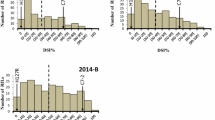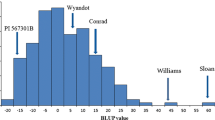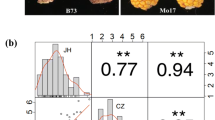Abstract
Fusarium graminearum Schwabe, the conidial form of Gibberella zeae, is the causal fungal pathogen responsible for Gibberella stalk rot of maize. Using a BC1F1 backcross mapping population derived from a cross between ‘1145’ (donor parent, completely resistant) and ‘Y331’ (recurrent parent, highly susceptible), two quantitative trait loci (QTLs), qRfg1 and qRfg2, conferring resistance to Gibberella stalk rot have been detected. The major QTL qRfg1 was further confirmed in the double haploid, F2, BC2F1, and BC3F1 populations. Within a qRfg1 confidence interval, single/low-copy bacterial artificial chromosome sequences, anchored expressed sequence tags, and insertion/deletion polymorphisms, were exploited to develop 59 markers to saturate the qRfg1 region. A step by step narrowing-down strategy was adopted to pursue fine mapping of the qRfg1 locus. Recombinants within the qRfg1 region, screened from each backcross generation, were backcrossed to ‘Y331’ to produce the next backcross progenies. These progenies were individually genotyped and evaluated for resistance to Gibberella stalk rot. Significant (or no significant) difference in resistance reactions between homozygous and heterozygous genotypes in backcross progeny suggested presence (or absence) of qRfg1 in ‘1145’ donor fragments. The phenotypes were compared to sizes of donor fragments among recombinants to delimit the qRfg1 region. Sequential fine mapping of BC4F1 to BC6F1 generations enabled us to progressively refine the qRfg1 locus to a ~500-kb interval flanked by the markers SSR334 and SSR58. Meanwhile, resistance of qRfg1 to Gibberella stalk rot was also investigated in BC3F1 to BC6F1 generations. Once introgressed into the ‘Y331’ genome, the qRfg1 locus could steadily enhance the frequency of resistant plants by 32–43%. Hence, the qRfg1 locus was capable of improving maize resistance to Gibberella stalk rot.





Similar content being viewed by others
References
Afolabi CG, Ojiambo PS, Ekpo EJA, Menkir A, Bandyopadhyay R (2008) Novel sources of resistance to Fusarium Stalk Rot of maize in tropical Africa. Plant Dis 92:772–780
Basten CJ, Weir BS, Zeng ZB (1997) QTL cartographer: a reference manual and tutorial for QTL mapping. Department of Statistics, North Carolina State University, Raleigh, NC
Chambers KR (1987) Stalk rot of maize: host–pathogen interaction. J Phytopathol 118:103–108
Chambers KR (1988) Effect of time of inoculation on Diplodia stalk and ear rot of maize in South Africa. Plant Dis 72:529–531
Cook RJ (1978) The incidence of stalk rot (Fusarium spp.) on maize hybrids and its effect on yield of maize in Britain. Ann Appl Biol 88:23–30
Darvasi A (1998) Experimental strategies for the genetic dissection of complex traits in animal models. Nat Genet 18:19–24
Francis RG, Burgess LW (1975) Surveys of Fusaria and other fungi associated with stalk rot of maize in Eastern Australia. Aust J Agric Res 26:801–807
Frey TJ (2005) Fine-mapping, cloning, verification, and fitness evaluation of a QTL, Rcg1, which confers resistance to Colletotrichum graminicola in maize. PhD Dissertation, University of Delaware
Jung M, Weldekidan T, Schaff D, Paterson A, Tingey S, Hawk J (1994) Generation-means analysis and quantitative trait locus mapping of anthracnose stalk rot genes in maize. Theor Appl Genet 89:413–418
Koehler B (1960) Cornstalk rots in Illinois. Ill Agric Exp Stn Bull 658:90
Kosambi DD (1944) The estimation of map distances from recombination values. Ann Eugen 12:172–175
Lal S, Singh IS (1984) Breeding for resistance to downy mildews and stalk rots in maize. Theor Appl Genet 69:111–119
Lauter N, Moscou MJ, Habiger J, Moose SP (2008) Quantitative genetic dissection of shoot architecture traits in maize: towards a functional genomics approach. Plant Genome 1:99–110
Ledencan T, Simic D, Brkic I, Jambrovic A, Zdunic Z (2003) Resistance of maize inbreds and their hybrids to Fusarium stalk rot. Czech J Genet Plant Breed 39:15–20
Li Q, Wan JM (2005) SSRHunter: development of a local searching software for SSR sites. Hereditas (Beijing) 27(5):808–810
Li CX, Su J, Gong SC, Song XZ, Li GL, Hu GH, Wang MQ (2001) Study on inoculated methods of corn stalk rot. J Maize Sci (Chinese) 9:72–74
Li J, Thomson M, McCouch SR (2004) Fine mapping of a grain-weight quantitative trait locus in the pericentromeric region of rice chromosome 3. Genetics 168:2187–2195
Lincoln S, Daly M, Lander E (1992) Mapping genetic mapping with MAPMAKER/EXP3.0. Whitehead Institute Technical Report, Cambridge
Lu GZ, Chen J, Liu WC, Zhou YL, Zhao TC, Liang JY, Bai QK (1995) The pathogens of corn stalk rot and variety resistance. J Maize Sci (Chinese) 3:47–51
Mackill DJ (2007) Molecular markers and marker-assisted selection in rice. In: Varshney RK, Tuberosa R (eds) Genomics assisted crop improvement. CRC Press, Boca Raton, pp 147–168
Mei LY (2003) Current situation in research of pathogenic fungi of corn stalk rot. Heilongjiang Agric Sci 5:35–36
Melchinger AE, Utz HF, Schön CC (1998) Quantitative trait locus (QTL) mapping using different testers and independent population samples in maize reveals low power of QTL detection and large bias in estimates of QTL effects. Genetics 149:383–403
Murray MG, Thompson WF (1980) Rapid isolation of high molecular weight plant DNA. Nucleic Acids Res 8:4321–4326
Parry DW, Jenkinson P, McLeod L (1995) Fusarium ear blight (scab) in small grain cereals—a review. Plant Pathol 44:207–238
Pè ME, Gianfranceschi L, Taramino G, Tarchini R, Angelini P, Dani M, Binelli G (1993) Mapping quantitative trait loci (QTLs) for resistance to Gibberella zeae infection in maize. Mol Gen Genet 241:11–16
Salvi S, Tuberosa R (2005) To clone or not to clone plant QTLs: present and future challenges. Trends Plant Sci 10:297–304
Salvi S, Sponza G, Morgante M, Tomes D, Niu XM, Fengler KA, Meeley R, Ananiev EV, Svitashev S, Bruggemann E, Li BL, Hainey CF, Radovic S, Zaina G, Rafalski JA, Tingey SV, Miao GH, Phillips RL, Tuberosa R (2007) Conserved noncoding genomic sequences associated with a flowering-time quantitative trait locus in maize. Proc Natl Acad Sci USA 104:11376–11381
Schön CC, Utz HF, Groh S, Truberg B, Openshaw S, Melchinger AE (2004) Quantitative trait locus mapping based on re-sampling in a vast maize testcross experiment and its relevance to quantitative genetics for complex traits. Genetics 167:485–498
Tanksley SD (1993) Mapping polygenes. Annu Rev Genet 27:205–233
Tesso T, Claflin LE, Tuinstra MR (2004) Estimation of combining ability for resistance to Fusarium stalk rot in grain sorghum. Crop Sci 44:1195–1199
Todd LR, Kommedahl T (1994) Image analysis and visual estimates for evaluating disease reactions of corn to Fusarium stalk rot. Plant Dis 78:876–878
Toman JJ, White DG (1993) Inheritance of resistance to anthracnose stalk rot of corn. Phytopathology 83:981–986
University of Illinois (1995) Corn stalk rots. Rep Plant Dis 200:1–6
Visscher PM, Goddard ME (2004) Prediction of the confidence interval of quantitative trait loci location. Behav Genet 34:477–482
Wang XM (2001) Pathogenicity of pathogens and integrated control techniques of maize stalk rot. PhD Dissertation, China Agricultural University
Yang DE, Zhang CL, Zhang DS, Jin DM, Weng ML, Chen SJ, Nguyen H, Wang B (2004) Genetic analysis and molecular mapping of maize (Zea mays L.) stalk rot resistant gene Rfg1. Theor Appl Genet 108:706–711
Yang DE, Jin DM, Wang B, Zhang DS, Nguyen HT, Zhang CL, Chen SJ (2005) Characterization and mapping of Rpi1, a gene that confers dominant resistance to stalk rot in maize. Mol Gen Genomics 274:229–234
Young HCJ (1943) The toothpick method of inoculating corn for ear and stalk rots. Phytopathology 33:16
Young ND (1999) A cautiously optimistic vision for marker-assisted breeding. Mol Breed 5:505–510
Younis SEA, Abo-EI-Dnhab MK, Mallah GS (1969) Genetics studies of the resistance to Fusarium stalk rot in maize. Indian J Genet Pl Breed 29:418–425
Zeng ZB (1994) Precision mapping of quantitative trait loci. Genetics 136:1457–1468
Acknowledgments
We greatly appreciate the effort of Prof. Schuyler S. Korban from University of Illinois to thoroughly edit English language for this manuscript. We are grateful to Prof. Xiaoming Wang from Chinese Academy of Agricultural Sciences for his help in inoculum preparation and symptom diagnose in the field. This study was financially supported by the national outstanding youth foundation of China, grant No. 30525035; the national ‘863’ high-tech program of China, grant Nos. 2006AA10A107 and 2006AA10A103; the national ‘973’ basic research program; and the Beijing agricultural innovative platform-Beijing natural science fund program, grant No. D08070500690802.
Author information
Authors and Affiliations
Corresponding author
Additional information
Communicated by M. Bohn.
Q. Yang and G. Yin contributed equally to this research.
Rights and permissions
About this article
Cite this article
Yang, Q., Yin, G., Guo, Y. et al. A major QTL for resistance to Gibberella stalk rot in maize. Theor Appl Genet 121, 673–687 (2010). https://doi.org/10.1007/s00122-010-1339-0
Received:
Accepted:
Published:
Issue Date:
DOI: https://doi.org/10.1007/s00122-010-1339-0




